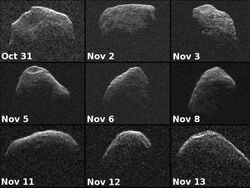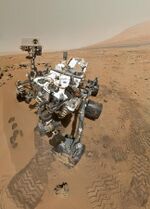Astronomy:(214869) 2007 PA8
 Goldstone radar image of 2007 PA8 during its 2012 close approach | |
| Discovery[1] | |
|---|---|
| Discovered by | LINEAR |
| Discovery site | Lincoln Lab's ETS |
| Discovery date | 9 August 2007 |
| Designations | |
| (214869) 2007 PA8 | |
| 2007 PA8 | |
| Minor planet category | Apollo · NEO · PHA[1][2] |
| Orbital characteristics[1] | |
| Epoch 4 September 2017 (JD 2458000.5) | |
| Uncertainty parameter 0 | |
| Observation arc | 10.83 yr (3,957 days) |
| |{{{apsis}}}|helion}} | 4.6931 AU |
| |{{{apsis}}}|helion}} | 0.9571 AU |
| 2.8251 AU | |
| Eccentricity | 0.6612 |
| Orbital period | 4.75 yr (1,734 days) |
| Mean anomaly | 1.4149° |
| Mean motion | 0° 12m 27.36s / day |
| Inclination | 1.9841° |
| Longitude of ascending node | 142.63° |
| 292.33° | |
| Earth MOID | 0.0246 AU (9.6 LD) |
| Jupiter MOID | 0.6318 AU |
| Physical characteristics | |
| Mean diameter | 1.35±0.07 km[3] 1.38 km (calculated)[4] 1.4±0.2 km[5] |
| Rotation period | 85±12 h[4] 95±5 h[6] 101.209 h[1] 101.325±1.2659 h[7] 102.24±0.48 h[3] |
| Geometric albedo | 0.20 (assumed)[4] 0.29±0.08[5] 0.29±0.14[3] |
| C[6] · Q[5] · S[4] B–V = 0.765±0.022[4] V–R = 0.415±0.011[4] V–I = 0.741±0.015[4] | |
| Absolute magnitude (H) | 16.2[5] · 16.216±0.002 (R)[7] · 16.30±0.52[3] · 16.4[1] · 16.47[6] · 16.67[4] |
(214869) 2007 PA8 is an asteroid and slow rotator, classified as near-Earth object and potentially hazardous asteroid of the Apollo group, approximately 1.4 kilometers in diameter.
It came within 6.5 million km (4 million miles, 17 lunar distances) of Earth on 5 November 2012.[8][9]
It was discovered on 9 August 2007, by the Lincoln Near-Earth Asteroid Research team (LINEAR) at the U.S. Lincoln Laboratory Experimental Test Site in Socorro, New Mexico.[2]
It was studied by the 70-meter (230 ft) Goldstone Deep Space Network antenna as it came near Earth, which resulted in radar images and other data about the asteroid, such as its very long rotation period of approximately 100 hours.[9]
2007 PA8 may be a dormant comet related to the November γ Pegasids meteor shower.[10]
Numbering and naming
This minor planet was numbered by the Minor Planet Center on 9 May 2009.[11] As of 2018, it has not been named.[2]
See also
References
- ↑ 1.0 1.1 1.2 1.3 1.4 "JPL Small-Body Database Browser: 214869 (2007 PA8)". Jet Propulsion Laboratory. https://ssd.jpl.nasa.gov/sbdb.cgi?sstr=2214869;cad=1.
- ↑ 2.0 2.1 2.2 "214869 (2007 PA8)". Minor Planet Center. https://www.minorplanetcenter.net/db_search/show_object?object_id=214869.
- ↑ 3.0 3.1 3.2 3.3 Brozovic, Marina; Benner, Lance A. M.; Magri, Christopher; Scheeres, Daniel J.; Busch, Michael W.; Giorgini, Jon D. et al. (April 2017). "Goldstone radar evidence for short-axis mode non-principal-axis rotation of near-Earth asteroid (214869) 2007 PA8". Icarus 286: 314–329. doi:10.1016/j.icarus.2016.10.016. Bibcode: 2017Icar..286..314B. http://adsabs.harvard.edu/cgi-bin/bib_query?bibcode=2017Icar..286..314B. Retrieved 26 April 2017.
- ↑ 4.0 4.1 4.2 4.3 4.4 4.5 4.6 4.7 "LCDB Data for (214869)". Asteroid Lightcurve Database (LCDB). http://www.minorplanet.info/PHP/generateOneAsteroidInfo.php?AstInfo=214869%7C.
- ↑ 5.0 5.1 5.2 5.3 Fornasier, S.; Belskaya, I. N.; Perna, D. (April 2015). "The potentially hazardous Asteroid (214869) 2007 PA8: An unweathered L chondrite analog surface". Icarus 250: 280–286. doi:10.1016/j.icarus.2014.12.015. Bibcode: 2015Icar..250..280F. http://adsabs.harvard.edu/cgi-bin/bib_query?bibcode=2015Icar..250..280F. Retrieved 26 April 2017.
- ↑ 6.0 6.1 6.2 Hicks, M.; Brewer, M.; Somers, J. (December 2012). "Broadband Photometry of 214869 (2007 PA8): A Slowly Rotating Potentially Hazardous Asteroid.". The Astronomer's Telegram (4625). Bibcode: 2012ATel.4625....1H. http://adsabs.harvard.edu/cgi-bin/bib_query?bibcode=2012ATel.4625....1H. Retrieved 26 April 2017.
- ↑ 7.0 7.1 Waszczak, Adam; Chang, Chan-Kao; Ofek, Eran O.; Laher, Russ; Masci, Frank; Levitan, David et al. (September 2015). "Asteroid Light Curves from the Palomar Transient Factory Survey: Rotation Periods and Phase Functions from Sparse Photometry". The Astronomical Journal 150 (3): 35. doi:10.1088/0004-6256/150/3/75. Bibcode: 2015AJ....150...75W. http://adsabs.harvard.edu/cgi-bin/bib_query?bibcode=2015AJ....150...75W. Retrieved 26 April 2017.
- ↑ Major, Jason (6 November 2012). "Say Hello to Asteroid 2007 PA8". Universe Today. https://www.universetoday.com/98347/say-hello-to-asteroid-2007-pa8/.
- ↑ 9.0 9.1 (214869) 2007 PA8 Goldstone Radar Observations Planning
- ↑ Rudawska, Regina (2014). "New meteor showers identified in the CAMS and SonotaCo meteoroid orbit surveys". Proceedings of the Meteoroids 2013 Conference Aug. 26-30, 2013, A.M. University, Poznan, Poland: 217. Bibcode: 2014me13.conf..217R. https://archive.org/details/arxiv-1405.1769.
- ↑ "MPC/MPO/MPS Archive". Minor Planet Center. https://www.minorplanetcenter.net/iau/ECS/MPCArchive/MPCArchive_TBL.html.
External links
- NASA Radar Images Asteroid 2007 PA8 (5 November 2012)
- Nine Radar Images of Asteroid 2007 PA8 (26 November 2012)
- Asteroid Lightcurve Database (LCDB), query form (info )
- Asteroids and comets rotation curves, CdR – Observatoire de Genève, Raoul Behrend
- (214869) 2007 PA8 at NeoDyS-2, Near Earth Objects—Dynamic Site
- Ephemeris · Obs prediction · Orbital info · MOID · Proper elements · Obs info · Close · Physical info · NEOCC
- (214869) 2007 PA8 at ESA–space situational awareness
- (214869) 2007 PA8 at the JPL Small-Body Database
 |



